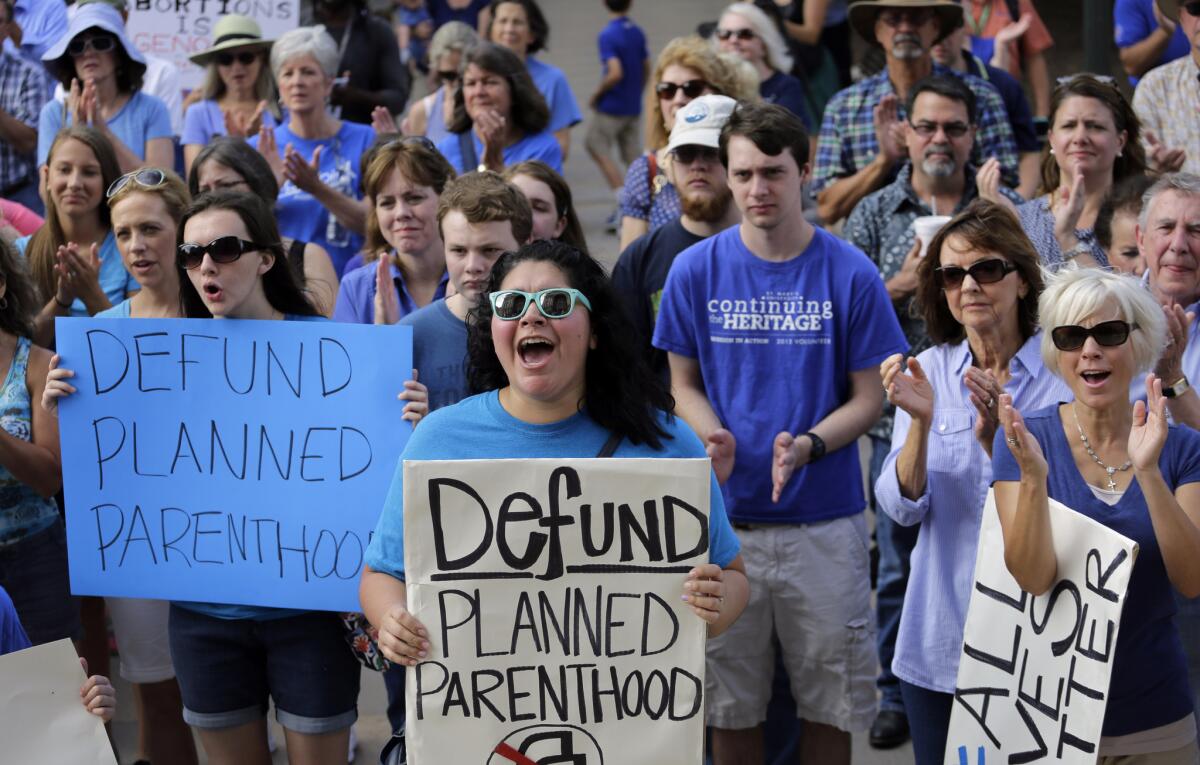After Texas stopped funding Planned Parenthood, low-income women had more babies

Antiabortion activists rally outside the Texas Capitol in Austin. A new study links the defunding of Planned Parenthood and other family planning clinics in the state with a rise in births among low-income women.
- Share via
The state of Texas’ sustained campaign against Planned Parenthood and other family planning clinics affiliated with abortion providers appears to have led to an increase in births among low-income women who lost access to affordable and effective birth control, a new study says.
The analysis, published Wednesday in the New England Journal of Medicine, documents a significant increase in births among women who had previously received birth control at clinics that no longer get state funding.
The researchers, from the Population Research Center at the University of Texas at Austin, say their findings offer a sneak peek of what may happen in other states that have cut funding to Planned Parenthood.
Join the conversation on Facebook >>
Lawmakers in Arkansas, Alabama, New Hampshire, Louisiana, North Carolina and Utah have enacted policies to keep public funds out of Planned Parenthood clinics. Ohio is expected to be the next state to follow suit.
These laws “definitely” had a real impact on women, said study leader Joseph Potter, a sociologist at the university. “It’s not like there is a large, over-capacity of highly qualified providers of effective contraception out there just waiting for people to show up,” he said.
The first blow to Planned Parenthood and other family planning clinics in Texas came in 2011, when lawmakers cut family-planning grants by 66% across the state. The money that remained was directed toward community health centers and county health departments that provide more comprehensive care.
This dramatic cut in funding was responsible for the closure of 82 family-planning clinics in the state, researchers said. About one-third of them were affiliated with Planned Parenthood.
News reports at the time suggested the move was motivated, at least in part, by a desire to keep money away from groups that might refer women to abortion clinics.
“Of course this is a war on birth control and abortions and everything — that’s what family planning is supposed to be about,” then-state Rep. Wayne Christian, an East Texas Republican, said in 2011.
The state’s federally funded Medicaid program was not allowed to steer funds away from Planned Parenthood clinics. So in 2013, the state ditched it and set up the state-funded Texas Women’s Health Program, which could legally withhold funds from any clinic affiliated with an abortion provider.
“It was exclusively Planned Parenthood that was hit by that,” Potter said.
Though only 23 of the 254 counties in Texas had a Planned Parenthood clinic before 2013, they served 60% of the state’s low-income women of childbearing age, according to the study.
The researchers make the case that the 2013 policy change made it more difficult for these women to get access to reliable birth control. Without it, they were more likely to get pregnant and have babies.
They began by comparing contraceptive use before and after Texas cut funding to Planned Parenthood and saw a “sharp decrease” in the use of long-acting reversible contraceptives in the counties that had been served by a Planned Parenthood, the study authors wrote. These included intra-uterine devices, or IUDs, which prevent sperm from fertilizing an egg for up to 10 years, and matchstick-sized implants that are inserted under the skin and release hormones to halt ovulation for up to three years.
They also saw that demand for hormone injections, which prevent ovulation for three months at a time, “fell sharply” in counties that lost their Planned Parenthood clinics.
In the three months before funding was cut, there were 1,042 pharmacy and medical claims for IUDs, implants and birth control injections. In the three months after the cuts were implemented, that number fell to 672. That represents a decline of nearly 36%, according to the study.
These trends were not seen in counties that hadn’t had a Planned Parenthood, the study authors wrote.
Next, the researchers examined the consequences of these changes in birth control use. They focused on hormone injections, since they wear off more quickly.
Among women in Planned Parenthood counties who got the shots in the last three months of 2011, 57% got a follow-up shot in the first three months of 2012, when the clinics were still operating. A year later, among women who got a birth control shot in the last three months of 2012, 38% got a follow-up shot in the first three months of 2013, after the clinics in their counties had closed.
Meanwhile, women in counties that didn’t have a Planned Parenthood in any of those years saw a slight uptick in injectable contraception use, from 55% at the end of 2011 to almost 59% at the end of 2012.
Without that reliable form of birth control, pregnancies increased and more babies were born, the study authors found. Over 18 months, the proportion of these women who gave birth to a child rose from 7% to 8.4% in counties that lost a Planned Parenthood.
Meanwhile, in counties that hadn’t been served by a Planned Parenthood, the proportion of low-income women who had used hormone injections and then had babies fell from 6.4% to 5.9% over the same 18-month period.
The researchers calculated that the relative increase in births was 27% for women who lost access to Planned Parenthood. Many of these births were probably unplanned, since the increase was only seen in counties where women faced new hurdles in access to contraception, the study authors wrote.
“To see such a large increase in such a short time was surprising,” said graduate student Amanda Stevenson, the first author on the paper. “It takes a while for the shot to wear off, and then waiting time to get pregnant, and the pregnancy itself.”
The study doesn’t prove that the change in Texas policy was directly responsible for the increase in births, the researchers noted. But after making it more difficult for women to get safe, reliable birth control, women switched to less reliable contraceptive methods, or skipped them altogether. The result is dozens of additional babies born to some of the thousands of women who had been served by the shuttered clinics.
“This new research shows the devastating consequences for women when politicians block access to care at Planned Parenthood,” Cecile Richards, president of Planned Parenthood of America, said in a statement. “Politicians have claimed time and again that our patients can simply go to other health care providers — and tragically that’s not the case.”
Dr. Hal C. Lawrence III, executive vice president of the American Congress of Obstetricians and Gynecologists, said he’s not surprised that reduced access to long-acting reversible contraceptives would result in an increase in childbirth.
“These birth control methods are among the most effective ways of preventing unplanned pregnancy,” he said. Cutting funding to clinics makes birth control “inaccessible for many low-income women, inevitably driving up rates of unintended pregnancies with all their attendant costs and concerns.”
Do you love science? So do I! Follow me at @DeborahNetburn and “like” Los Angeles Times Science & Health on Facebook.
ALSO
Scientists 3D-print a ‘brain’ to learn the secret behind its folds
Why doctors are swiping C-section babies with their mom’s microbiome
CDC to younger women: Better take your birth control before you drink that glass of wine







